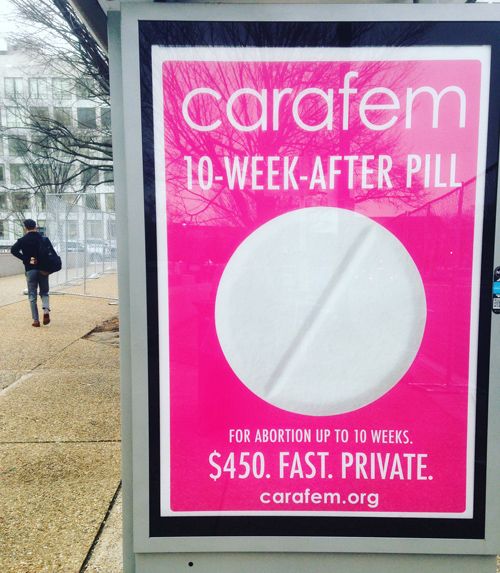The Science Behind the “Abortion Pill”
Legal or not, more American women are opting for abortion by medication. We asked doctors: How safe is it?
/https://tf-cmsv2-smithsonianmag-media.s3.amazonaws.com/filer/88/ef/88ef18a9-1ffd-4466-abba-3f001b2b86b3/hkn962.jpg)
Roe v. Wade may have legalized abortion in America 45 years ago, but the fight it ignited is far from over. While abortion is still legal, many states have since passed laws that restrict access to abortion to varying degrees—making it more expensive, difficult or even illegal in specific circumstances to terminate a pregnancy. Today abortion clinics are disappearing at a record pace, and Medicaid payouts to Planned Parenthood are in jeopardy.
As a result, many women do not have access to a safe clinical abortion.
“The fact that a clinic exists in her state doesn’t help a woman who lives far away from that clinic and has no way to get there,” says Susan Yanow, a reproductive health consultant for the international nonprofit Women Help Women (WHW). Seven states—Kentucky, North Dakota, South Dakota, Missouri, Mississippi, Wyoming and West Virginia—currently have only one abortion provider, and Kentucky may soon be the only state with none.
Now some women are once again taking the procedure outside the doctor's office, outside the law, and into their own hands. While the days of the infamous wire coat hanger aren't quite over, many women are turning to a safer method made possible by modern medicine: the “abortion pill.”
For those with access to a clinic, the abortion pill has become an increasingly popular way to legally terminate an early pregnancy. The Food and Drug Administration mandates that medication can only be prescribed by a healthcare provider "who meets certain qualifications"; 19 states also require that a physician be there physically to supervise the procedure.
Anti-abortion activists argue against the safety of using this method outside a doctor's office, and have even argued that states should require stricter medical supervision for abortion medication. “These drugs are dangerous. They are deadly. If they are mishandled, they result in serious injury,” Kristi Hamrick, spokeswoman for the antiabortion group Americans United for Life, recently told The Washington Post. (Hamrick is not a physician.)
But women who can't get the medication legally can and do buy it illegally, either online or in Mexico. In fact, this is fast becoming the primary option for women who lack others: In 2015, more than 700,000 Google users in the U.S. typed in queries about self-induced abortions, including “buy abortion pills online” and “free abortion pills,” according to the New York Times. In May 2016, Glamour magazine chronicled the stories of women seeking these pills in “The Rise of the DIY Abortion.”
That’s why, in April, WHW launched its first website to assist American women undergoing medical abortions on their own. “The new Trump administration and anti-abortion legislatures in many states are moving swiftly to push abortion out of reach,” said Kinga Jelinska, the group’s executive director, in a statement announcing the move. The new website, Abortionpillinfo.com, provides women with confidential, one-on-one counseling on how to safely use their abortion medication—regardless of where they may have obtained it.
It isn't clear just how many women are seeking abortion medication outside of a clinic. To protect its clients, WHW does not disclose how many inquiries its trained counselors receive. But in the past several years, many women have been charged for buying or taking it illegally, with several facing felony charges and jail time. As use of the abortion pill spreads outside the doctor’s office and into murky legal waters, we asked: How does this procedure work? And how safe is it?
...

While it's used by many abortion clinics, the name “abortion pill” is a bit misleading. Medical clinics actually administer two different types of medication: one mifepristone pill (which goes by the brand name Mifeprex), and four misoprostol tablets.
How does it work? The first dose—a 200 mg mifepristone pill—begins the process by blocking the body’s progesterone, a hormone that is needed to continue a pregnancy in its early stages. “Whenever a woman has a period, part of what stimulates that period is the withdrawal of progesterone,” says Dr. Lauren Thaxton, an obstetrician-gynecologist in Albuquerque, New Mexico who has been performing abortions for six years
By blocking this hormone, the first pill helps break down the uterine lining that a woman normally sheds during her period, so that the embryo can detach from the uterine wall. After that happens (generally one to two days after taking the first mifepristone pill), a woman dissolves four 200 mcg misoprostol tablets in her mouth. This second medication, which is also used to induce labor, helps expel the detached embryo.
Misoprostol “is in a class of medications called prostaglandins,” says obstetrician-gynecologist Dr. Daniel Grossman, who is the director of Advancing New Standards in Reproductive Health and co-author of a recent paper exploring the possibility of moving early abortion medication over the counter. “One of the effects of prostaglandins [is] that they cause what’s called cervical ripening—meaning causing the cervix to soften, open up, and become thinner. And it also causes the uterus to contract.”
Misoprostol was first developed in the U.S. in 1973 to treat peptic ulcers, which it did by preventing harsh gastric secretions. But it had known, major side-effects on a pregnant uterus. In the 1980s, French researchers developed mifepristone, also known as RU-486, a pill that could be taken in sequence with misoprostol to induce an abortion. France legalized this regimen in 1988, and China, Great Britain and Sweden soon followed suit.
In the U.S., reproductive rights activists hoped the FDA would adopt the method in the '90s, but anti-abortion activists helped delay its approval until 2000. When the U.S. first legalized abortion medication, it was available up to seven weeks after pregnancy. Women receiving it had to visit a clinic three times—once to take the mifepristone, a second time to take the misoprostol, and a third time for a follow-up.
In 2016, the FDA extended the pregnancy period to 10 weeks and reduced the number of required visits to two, meaning that women could now take the misoprostol at home (though some states have restricted that as well). Today there are even clinics that aim to de-stigmatize the process by offering a "spa-like experience," like a Maryland Carafem health center that offers hot tea and robes to women seeking medical abortions.
One to two weeks after taking the medication, the woman returns to the clinic to make sure the pregnancy has passed. When taken between nine and 10 weeks into a pregnancy, mifepristone and misoprostol are 93 percent effective at inducing an abortion, according to Planned Parenthood. The earlier they are taken, the more effective they are.
In 2014, almost half of U.S. hospital and clinical abortions performed before nine weeks were medication abortions, according to estimates from the Guttmacher Institute, a research and policy organization for reproductive rights. But if WHW’s new counseling services, Google queries and the increase in articles on DIY abortions are any indication, many more medical abortions may be happening outside the clinic.
...

...
Cara Harshman, a freelance writer and marketer in San Francisco, had her (legal) medication abortion in January. In an interview, she said that her symptoms of cramps, bleeding and nausea lasted for about five days after taking the misoprostol. By the time she had her follow-up appointment, she was stable and feeling healthy. She wrote about her experience on the Facebook group Pantsuit Nation in an essay she then re-published on Medium and Shout Your Abortion.
The only health issue that came up during Harshman’s abortion was a blood test showing she was Rh negative, a rare blood type, meaning she had to receive a shot of the medication RhoGAM after taking the misoprostol. According to Thaxton, most women are Rh positive. But “if a woman is Rh neg, pregnant and having bleeding,” she needs to receive RhoGAM “to prevent alloimmunization in future pregnancies, which is a condition wherein the mother develops an immune response to fetal red blood cells,” Thaxton wrote in an email.
“Overall [a medication abortion] is extremely safe,” says Thaxton, who is also a member of Physicians for Reproductive Health. Common symptoms include nausea, cramping and heavy bleeding, similar to what women experience during a miscarriage. Thaxton generally tells her patients that if they soak through four maxi pads in two hours, that's too much bleeding, and they should consult their physician. “There’s a rare risk of [too much] bleeding—sometimes bleeding requiring a blood transfusion—and that can be related to the risk that the pregnancy has incompletely passed,” she says.
To prevent this, abortion providers will counsel women about whether they have a history of bleeding disorders before prescribing this method. There’s also a small risk of infections like endometritis (inflammation of the uterine lining) or the contraction of the bacterium Clostridium Sordellii, both of which can also occur after childbirth. However, Thaxton said that the instances of infections after medication abortions are “extremely, extremely rare.”
“Women are always screened for health conditions that might make a surgical abortion a safer option than the abortion pill,” Thaxton wrote in an email. “But for the vast majority of women, the abortion pill is a safe, private, effective way to have an abortion."
...
Both mifepristone and misoprostol are available to purchase online without a prescription, even though doing so is illegal under federal law (laws regarding inducing an abortion vary by state). Many women who have to resort to this method use only misoprostol, because it is easier to get on its own and is available over (or under) the counter in many Latin American countries.
Texas women have been getting misoprostol at Mexican pharmacies for years, The New York Times reported in 2013; while abortion in Mexico is legally restricted, the medication is sold over the counter for ulcers.
Research has found that a larger amount of misoprostol is needed to induce an abortion on its own, and it’s usually less effective than the combined method. During the first 12 weeks of pregnancy, a woman who takes three 800 mcg doses of misoprostol orally at least three hours apart has an 85 percent chance of having a complete abortion, according to a 2007 study in the International Journal of Gynecology and Obstetrics.
Yet some studies suggest that inducing an abortion using misoprostol alone is no less safe than the combined method. The World Health Organization recommends misoprostol as a safe alternative when mifepristone isn't available, and Grossman says he would use the misoprostol-only method if he didn't have access to mifepristone as well.
Over-the-counter abortion medication may sound pretty far-fetched in a country like the U.S., where even standard birth control requires a prescription in almost every state. Yet the fact that women are already managing their medication abortions on their own has led some to wonder: Could the abortion pill(s) ever be sold over-the-counter, as Grossman's study explored?
In a recent Guardian op-ed, he writes that limited research suggests women who take abortion medication on their own are doing so safely, adding that “there is no question that use of these medications has contributed to a reduction in abortion-related mortality worldwide.” Abortion medication, he argues, could one day meet the FDA’s requirements for over-the-counter drugs. In fact, the research group Gynuity Health Projects is already conducting an FDA-approved research project called TelAbortion to test the safety of women using mail-order medication and online consultation to perform their abortions at home.
Of course, future research will be needed to test these hypotheses. But even if the pill's at-home safety is confirmed, if history tells us anything, it's that efforts to make abortion more accessible will be fought every step of the way.